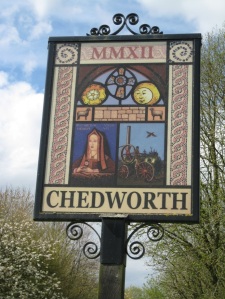Hello, Mrs Hg137 here again.
Our journey home from our weekend in and around Bourton on the Water started with a short drive to Naunton, a small village further up the River Windrush. I used to go on holiday here as a teenager, staying in the farmhouse adjacent to the Black Horse pub https://theblackhorsenaunton.co.uk/ Farmhouse, village, and pub have changed little in the last few decades – even the design on the pub sign is the same, though the car park has now become a beer garden, and the village shop is now a house.
We walked through the village, crossed the river, and reached a small green by the village church, St Andrews. There’s an ingeniously hidden Church Micro cache here, so we spent a few minutes working out where it was, then had a picnic lunch on a millennium bench on the green. After a quick look inside the church, we returned along a grassy path close to the river, following the Warden’s Way, which links the Oxfordshire Way at Bourton and the Cotswold Way at Winchcombe https://www.ldwa.org.uk/ldp/members/show_path.php?path_name=Wardens%27++Way

A footbridge took us back across the River Windrush, and close by on one side is another cache, ‘Pooh Sticks’; the cache is next to the bridge, and quite close to the water. It hadn’t been found for a couple of months and we weren’t sure if it was still there, but it was bravely retrieved by Mr Hg137, who emerged from the undergrowth with only a few nettle stings and scratches.
Also close to the river, in a little field, is a dovecote. There is a dovecote trust but I couldn’t find a website. Anyway, the dovecote was built around 1660, has had a variety of uses – as a mill, and animal stabling, apart from the obvious. But now it is back to housing doves, and it had cooing residents in some of its 903 nestholes when we looked inside.
We had one more cache to find, ‘Naunton Cricket Field’. But where was the cricket field and how could we get to it? After a little aimless wandering, we found our way around the back of the village hall and up a slope onto the cricket field. There’s been no play here for a bit and the outfield is a bit long! The cache was hidden at the edge of the pitch in a bit of cricket ‘furniture’.
As we returned to the geocars, I mused on my memories of my holidays in Naunton long ago. The village looks so similar, and pub, and its sign, look much the same, but the sign must have been repainted or replaced, surely?. But I don’t recall visiting the church or the dovecote, and didn’t even know about the cricket pitch and the village hall, assuming they were there at the time. We used to stay in a farmhouse owned by the Hanks, next to the pub, and I noticed the same surname cropping up on the cricket club website, so maybe there is a family connection there. Mmm, much to think on as we started our journey home.
























































































































